Hagia Sophia / Ayasofya
We finally arrive at Hagia Sophia, a building that we had heard about for years when we lived and travelled in Italy. Our first impression from the outside is that Ayasofya is ugly! So why is everyone coming here? Do you know why?
Built in 537, it is a mongrel mess of sharp-edged walls and bulky buttresses. These are needed to help support the weight of the dome. Many times over the centuries there have been partial collapses of the domes thanks to earthquakes.
Hagia Sophia (Greek) or Ayasofya (Turkish) means "Holy Wisdom". While it has minarets today, it served as the largest cathedral in the world for nearly a 1000 years until Seville’s Cathedral was completed in 1507.
Ayasofya Mosaics
Some of the best mosaics can be seen in the Vestibule of the Guards and the Interior Narthex. By contrast many of the mosaics in the main dome and half domes have flaked off.
The mosaic over the Imperial Gate, reserved for royalty, shows Emperor Leo VI kneeling and paying homage to Christ. Sitting on a throne, Christ is blessing the emperor with his right hand. Leo needed a son to inherit the throne but his first three wives had died. He had a son with his mistress and decided to marry her. Leo was excommunicated. Only two marriages were allowed in the Eastern Orthodox Church. Leo replaced the Patriarch, got his marriage recognized but had to do penance. The mosaic implies that the emperor is asking for forgiveness.
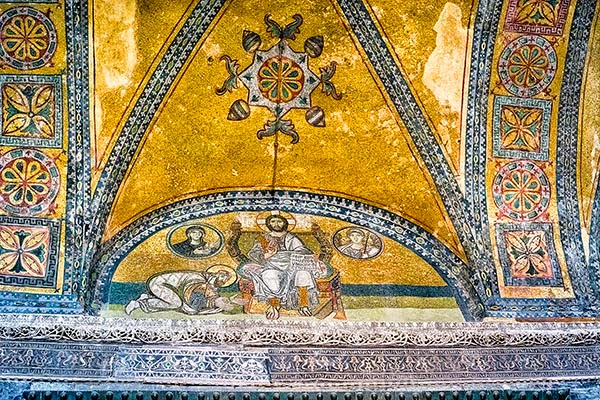 |
| Mosaic of Emperor Leo VI Paying Homage to Christ |
Ayasofya Dome
Hagia Sophia is famous for its dome, which rises 56 m (182 ft) above the floor with a diameter of 31 m (101 ft). Forty windows around the base not only flood light onto the Aya Sofya dome to make it appear to be floating, but they actually reduce the weight of the dome. It was not the largest dome erected, as it is smaller than the Pantheon on the Amazing Rome Walk 2, which is still standing. It is hard to appreciate the size of the church because half of the interior is shrouded in scaffolding and the crowds of tourists have even less space to move around. If this is how busy it is in off-season, I hate to see this place in peak season.
 |
| Hagia Sophia Domes |
Most of the prized art works of the interior were not damaged or stolen by the Ottoman Moslems but were carted off by Christians to Venice after the Sack of Constantinople (also known as the "Fourth Crusade") in 1204. Ayasofya still contains columns from the Temple of Artemis (Ephesus) and Baalbek (Lebanon), porphyry from Egypt, and two huge marble lustration (ritual purification) urns from Pergamum. Each urn was carved from a single block of marble in the Hellenistic period.
Most of the prized art works of the interior were not damaged or stolen by the Ottoman Moslems but were carted off by Christians to Venice after the Sack of Constantinople (also known as the "Fourth Crusade") in 1204. Ayasofya still contains columns from the Temple of Artemis (Ephesus) and Baalbek (Lebanon), porphyry from Egypt, and two huge marble lustration (ritual purification) urns from Pergamum. Each urn was carved from a single block of marble in the Hellenistic period.
Byzantine Empire
In the year 330, the Emperor Constantine the Great decided to move the seat of the government from Rome to Byzantium, which was renamed Constantinople. Rome fell in 476 but the eastern half of the Roman Empire continued. Istanbul was a significant city because it was the terminus of the Silk Routes (there were several) to Asia and the Black Sea routes to Russia. Important things to know are that:
- people of that time still called it the Roman Empire;
- the principle language of this empire was Greek not Latin;
- the term Byzantine Empire was only coined in the 16th century.
Hagia Sophia − Why is it Important?
Ayasofya became the model for the great mosques in the Ottoman Empire. In particular, the foremost Ottoman architect, Mimar Sinan based the Sultan Ahmed (Blue) and Süleymaniye Mosques (Istanbul) and the Selimiye Mosque (Edirne) on the dome-ination of Hagia Sophia. He used the same pendentive (triangular, spherical segment) to receive the weight of the dome at four corners. But he doubled the number of half domes that helped support the weight of the main dome. His arches more effectively transferred the weight of the dome to the four elephant piers.
Hagia Sophia has Impacted Architecture around the World
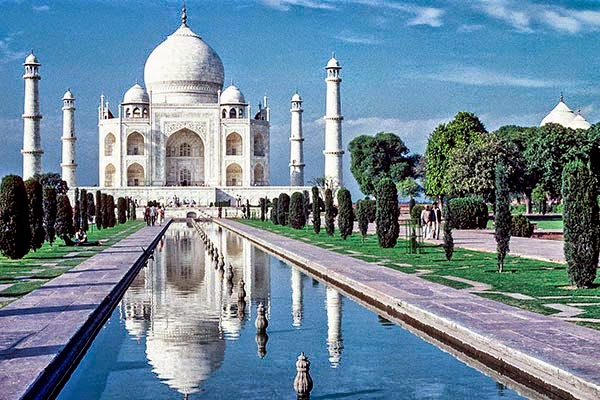 |
| Taj Mahal from Fountain |
Byzantine architecture is a mixture of Classical (Greek, Roman) and Oriental. Mosaics and semi-circular arches are two common features. In fact, the Romanesque Period of Europe (6th to 10th century) is a combination of Roman and Byzantine Architecture. After the fall of Rome, Byzantine Emperor Justinian (527–565) also reconquered a few provinces of Italy. For this reason, Ravenna and Venice have significant Byzantine artistic and architectural influences. Ravenna was called the capital of the West Roman Empire. It is famous for its mosaics in the Basilica di San Vitale (430 CE). In Istanbul, the peak of mosaic art occurs at the Chora Church.
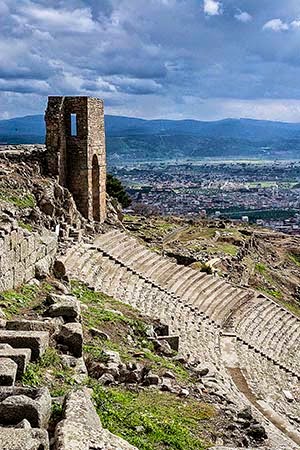



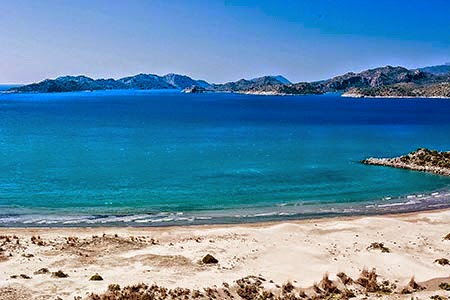


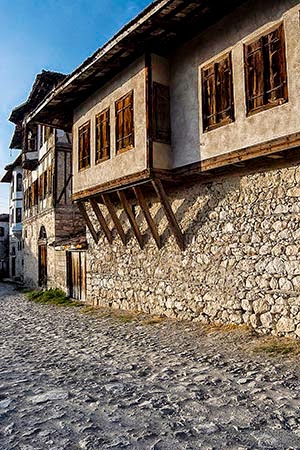


No comments:
Post a Comment
Please add your comments or questions